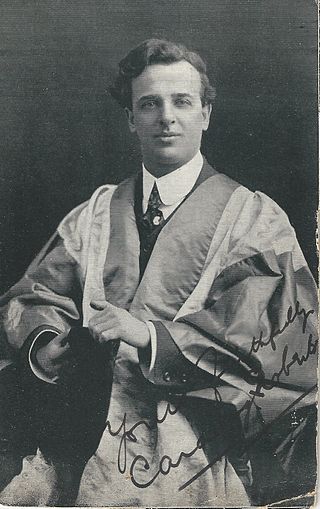The Christian Science Hymnal is a collection of hymns used in Christian Science church services including Sunday services and Wednesday evening testimony meetings, as well as in occasional informal hymn sings.

Horatio William Parker was an American composer, organist and teacher. He was a central figure in musical life in New Haven, Connecticut in the late 19th century, and is best remembered as the undergraduate teacher of Charles Ives while the composer attended Yale University.
Sir Sydney Hugo Nicholson was an English choir director, organist, composer, and founder of the Royal School of Church Music (RSCM) and the compiler of The Parish Psalter.

Anglican church music is music that is written for Christian worship in Anglican religious services, forming part of the liturgy. It mostly consists of pieces written to be sung by a church choir, which may sing a cappella or accompanied by an organ.
Erik Reginald Routley was an English Congregational churchman, theologian and musician and prominent hymnologist.
John Henry Maunder was an English composer and organist best known for his cantata "Olivet to Calvary".

Harold Edwin Darke was an English composer and organist. He is particularly known for his choral compositions, which are an established part of the repertoire of Anglican church music. Darke had a fifty-year association with the church of St Michael, Cornhill, in the City of London.

Hymns Ancient and Modern is a hymnal in common use within the Church of England, a result of the efforts of the Oxford Movement. The hymnal was first published in 1861. The organization publishing it has now been formed into a charitable trust, Hymns Ancient and Modern Ltd, and As of 2022 it publishes a wide range of hymnals as well as other theological and religious books and magazines, under imprints including the acquired publishers Canterbury Press and SCM Press.

John Ernest Bode was an Anglican priest, educator, poet, and hymnist.

"Nun bitten wir den Heiligen Geist" is the title of several hymns in German. The first is one of the oldest hymns in the German language: a 13th-century leise. Subsequent versions expanded upon the leise; the original hymn became the new version's first stanza, and it now used melodies derived from its medieval tune. The Protestant reformer Martin Luther expanded the leise in 1524, and different Catholic versions were published between 1537 and 1975.
Edwin George Monk, English church organist and composer, who was Organist and Master of Choristers at York Minster for a quarter of a century, and was previously associated with St Columba's and Radley Colleges. He was born on 13 December 1819 at Frome, Somerset, and died on 3 January 1900 at Radley, near Abingdon, Oxfordshire.

Caradog Roberts was a Welsh composer, organist and choirmaster.
Edmund Hart Turpin was an organist, composer, writer and choir leader based in Nottingham and London.

Philip Armes was an English organist, notably holding posts at Rochester, Chichester and Durham Cathedral.
"Vater unser im Himmelreich" is a Lutheran hymn in German by Martin Luther. He wrote the paraphrase of the Lord's Prayer in 1538, corresponding to his explanation of the prayer in his Kleiner Katechismus. He dedicated one stanza to each of the seven petitions and framed it with an opening and a closing stanza, each stanza in six lines. Luther revised the text several times, as extant manuscript show, concerned to clarify and improve it. He chose and possibly adapted an older anonymous melody, which was possibly associated with secular text, after he had first selected a different one. Other hymn versions of the Lord's Prayer from the 16th and 20th-century have adopted the same tune, known as "Vater unser" and "Old 112th".
The King of Love My Shepherd Is is an 1868 hymn with lyrics written by Henry Williams Baker, based on the Welsh version of Psalm 23 and the work of Edmund Prys.

"Breathe on Me, Breath of God" is an English Christian hymn. It was written by Edwin Hatch, a Church of England vicar and the Professor of Classics at the University of Trinity College in Canada. It was first published privately in 1878 and publicly published in 1886.
"For the beauty of the earth" is a sacred choral composition by John Rutter, a setting of the hymn of the same name by Folliott S. Pierpoint. The work was published by Oxford University Press in 1980. Recorded several times, it has been described as "one of Rutter's more popular, enduring anthems".

Olle Elgenmark was a Swedish organist and composer.
Dom Gregory Murray OSB was a British monk of Downside Abbey, and an organist and composer. His over-riding interest as a musician was to provide music that would enhance the Roman Catholic liturgy.










